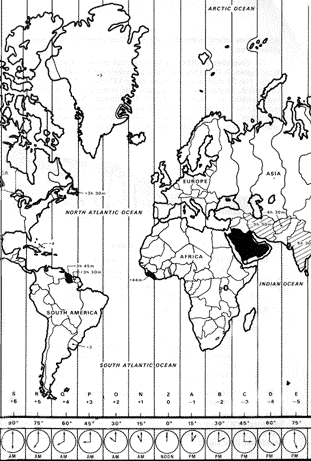A Walk Through Time - World Time Scales
In the 1840s a railway standard time for all of England, Scotland, and Wales evolved, replacing several "local time" systems. The Royal Observatory in Greenwich began transmitting time telegraphically in 1852 and by 1855 most of Britain used Greenwich time. Greenwich Mean Time (GMT) subsequently evolved as an important and well-recognized time reference for the world.
In 1830, the U.S. Navy established a depot, later to become the U.S. Naval Observatory (USNO), with the initial responsibility to serve as a storage site for marine chronometers and other navigation instruments and to "rate" (calibrate) the chronometers to assure accuracy for their use in celestial navigation. For accurate "rating," the depot had to make regular astronomical observations. It was not until December of 1854 that the Secretary of the Navy officially designated this growing institution as the "United States Naval Observatory and Hydrographic Office." Through all of the ensuing years, the USNO has retained timekeeping as one of its key functions.
With the advent of highly accurate atomic clocks, scientists and technologists recognized the inadequacy of timekeeping based on the motion of the Earth, which fluctuates in rate by a few thousandths of a second a day. The redefinition of the second in 1967 had provided an excellent reference for more accurate measurement of time intervals, but attempts to couple GMT (based on the Earth's motion) and this new definition proved to be highly unsatisfactory. A compromise time scale was eventually devised, and on January 1, 1972, the new Coordinated Universal Time (UTC) became effective internationally.
falseUTC runs at the rate of the atomic clocks, but when the difference between this atomic time and one based on the Earth approaches one second, a one second adjustment (a "leap second") is made in UTC. NIST's clock systems and other atomic clocks located at the USNO and in more than 25 other countries now contribute data to the international UTC scale coordinated in Paris by the International Bureau of Weights and Measures (BIPM). As atomic timekeeping has grown in importance, the world's standards laboratories have become more involved with the process, and in the United States today, NIST and USNO cooperate to provide official U.S. time for the nation. You can see a clock synchronized to the official U.S. government time provided by NIST and USNO at http://www.time.gov.
 The World's Time Zones
The World's Time Zones

In the latter part of the nineteenth century, a variety of meridians were used for longitudinal reference by various countries. For a number of reasons, the Greenwich meridian was the most popular of these. At least one factor in this popularity was the reputation for reliability and correctness of the Greenwich Observatory's publications of navigational data. It became clear that shipping would benefit substantially from the establishment of a single "prime" meridian, and the subject was finally resolved in 1884 at a conference held in Washington, where the meridian passing through Greenwich was adopted as the initial or prime meridian for longitude and timekeeping. Given a 24 hour day and 360 degrees of longitude around the earth, it is obvious that the world's 24 time zones have to be 15 degrees wide, on average. The individual zone boundaries are not straight, however, because they have been adjusted for the convenience and desires of local populations.
Interestingly, the standard timekeeping system related to this arrangement of time zones was made official in the United States by an Act of Congress in March 1918, some 34 years following the agreement reached at the international conference. In an earlier decision prompted by their own interests and by pressures for a standard timekeeping system from the scientific community — meteorologists, geophysicists and astronomers — the U.S. railroad industry anticipated the international accord when they implemented a "Standard Railway Time System" on November 18, 1883. This Standard Railway Time, adopted by most cities, was the subject of much local controversy for nearly a decade following its inception.
Notice of Online Archive: This page is no longer being updated and remains online for informational and historical purposes only. The information is accurate as of 2004. For questions about page contents, please pml-webmaster [at] nist.gov (subject: A%20Walk%20Through%20Time) (contact us).

